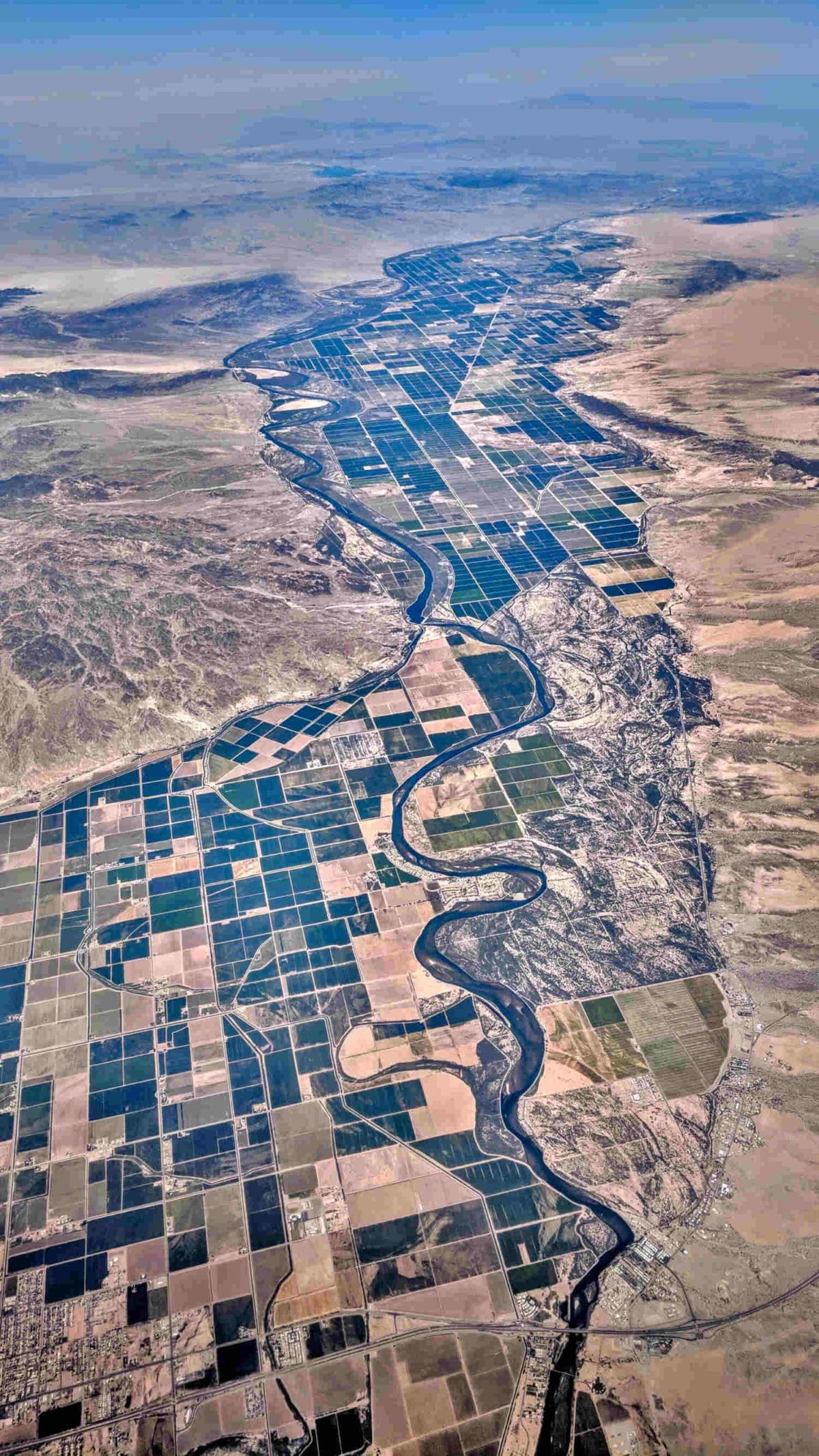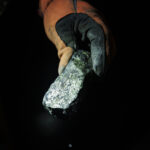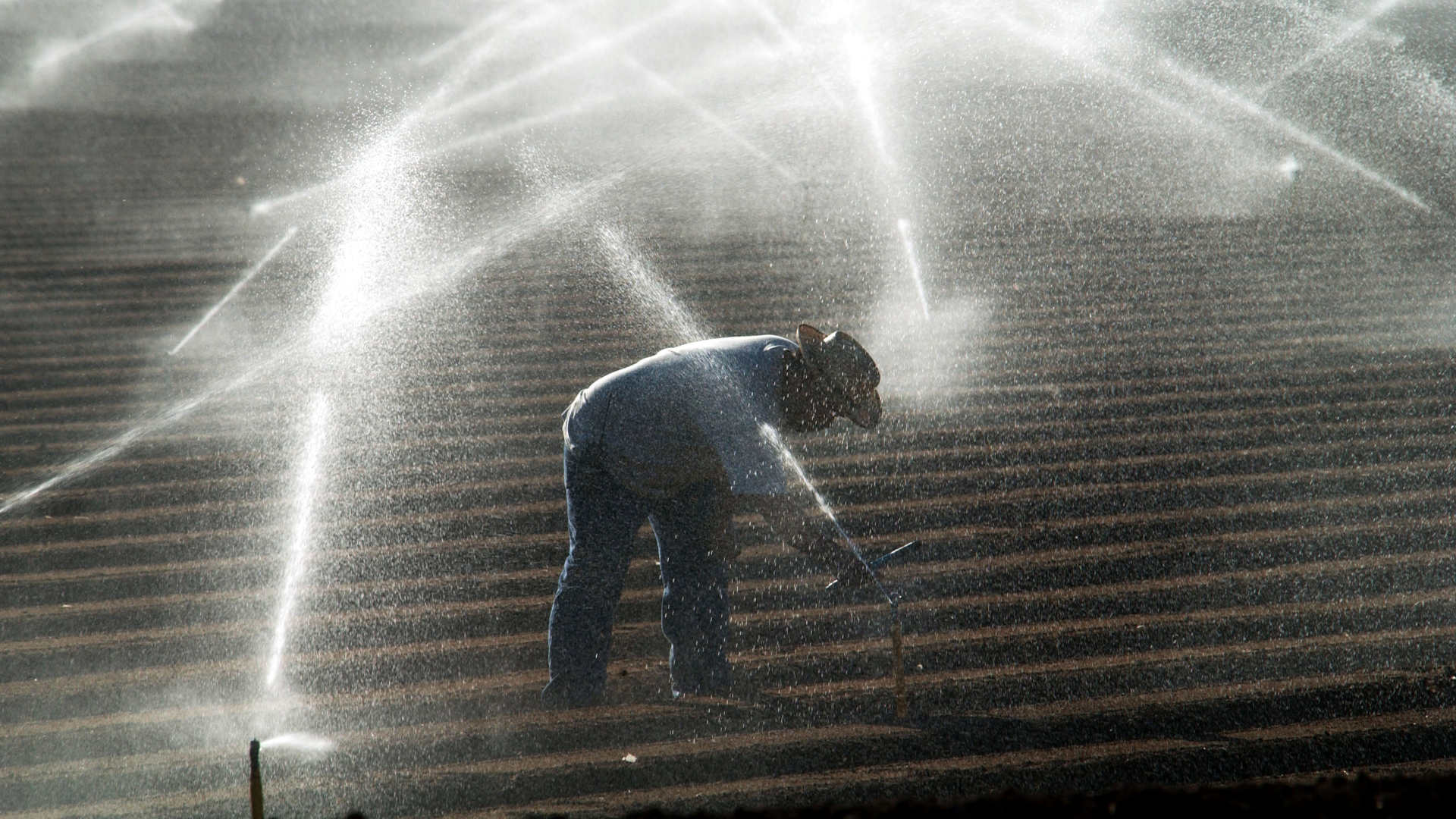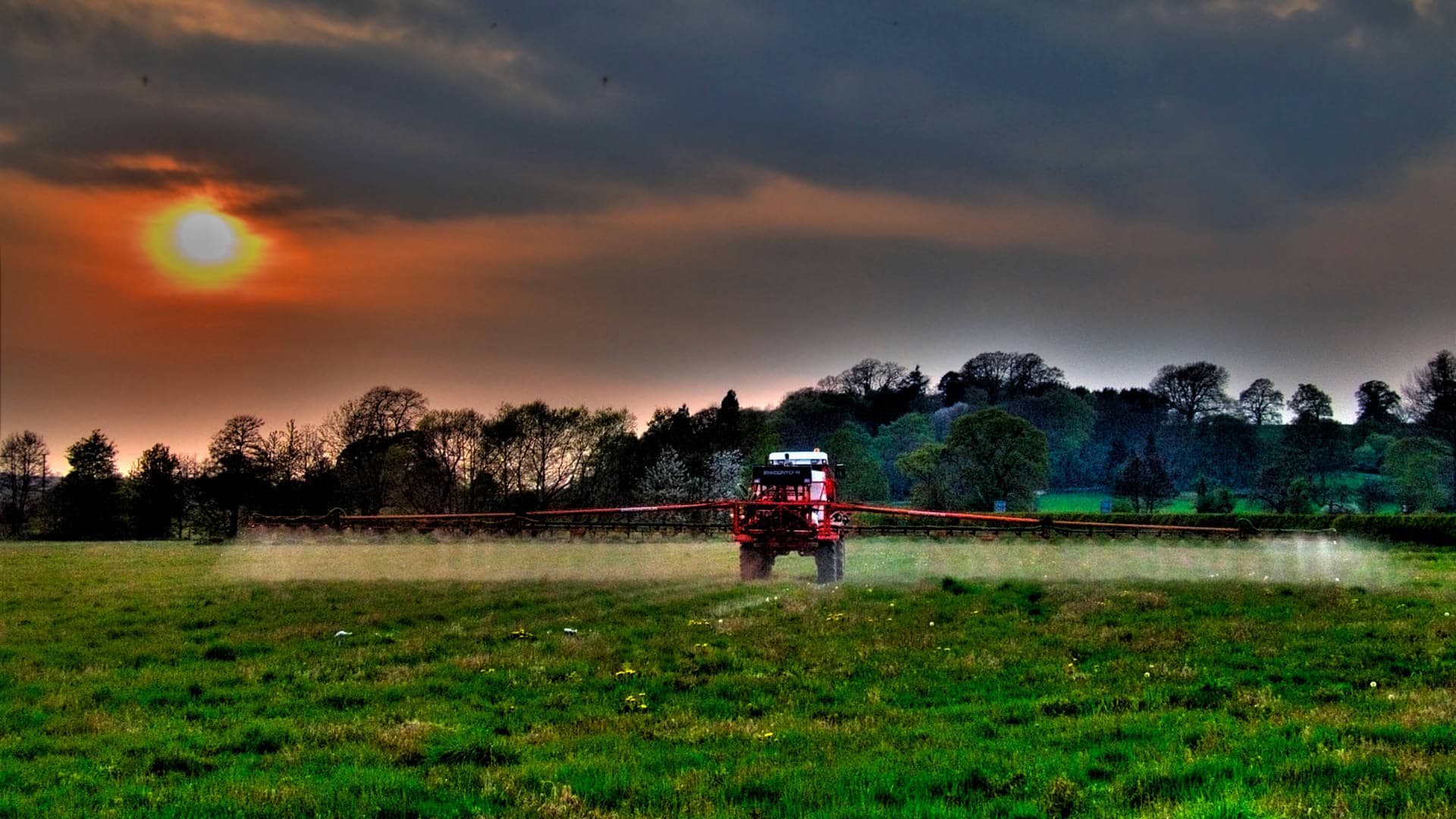U.S. Southwest, Already Parched, Sees ‘Virtual Water’ Drain Abroad
Driving into southern California’s Palo Verde Valley from the Arizona border, fields of vibrant green appear out of the desert like a mirage. Near the town of Blythe, water from the Colorado River turns the dry earth into verdant farmland, much of it to grow a single crop — alfalfa, a type of plant used mainly to feed dairy cows.
For decades, a significant portion of alfalfa grown here and elsewhere in the western United States — as much as 17 percent in 2017 — has been loaded onto trucks, driven hundreds of miles to ports on the west coast, and shipped around the world, mainly to China, Japan, and Saudi Arabia. A little over five years ago, one company decided it made more sense to own the land, and the water that came with it, outright.
The company, a Saudi Arabian dairy firm called Almarai, purchased 1,790 acres in the Palo Verde Valley to secure a supply of alfalfa for its dairy cows. Soon after, Saudi Arabia began phasing out domestic alfalfa production to preserve its water supplies, which were dwindling after years of overuse for agriculture. The purchase made headlines as critics including local politicians and environmentalists questioned whether it was fair for a foreign entity to use up valuable groundwater resources for products that wouldn’t ultimately benefit Americans.

The farms of the Palo Verde Valley draw water from the Colorado River.
Visual: Dicklyon / Wikimedia Commons
But the company is far from alone. Foreign corporations are increasingly purchasing land in the U.S.; in the Southwest, thanks to longstanding laws on water rights, these purchases often come with unlimited access to the valuable water underneath the soil. Combined with nearly year-round sunshine, this has made the area a magnet for companies looking to grow water-intensive crops and raise livestock. Over the last 20 years, foreign companies have purchased more than 250,000 acres of land in six Southwestern states to raise cattle and pigs, as well as to grow everything from almonds to alfalfa, according to an analysis of purchase data that Undark obtained from the U.S. Department of Agriculture.
On its face, foreign ownership of farmland hasn’t proved significantly different from American ownership for large-scale production of crops like alfalfa. Domestic farmers have long shipped food overseas, and companies like Almarai, as well as independent researchers, have suggested the outsized focus on foreign companies may be xenophobic. American farmers and companies also control millions of acres overseas, mainly in Africa, Asia, and South America. But with their implications for food and water security — that ultimately, the U.S. is not in control of its own farmland — the purchases are drawing attention to the larger trend of industrial agriculture in the U.S. and the problems that come with it.
Corporate farms, researchers and policymakers warn, drain aquifers and threaten access to water for drinking and future crop production. The export of crops and the water used to grow them, known as virtual water, has been accelerating for decades, despite concerns that in drought-stricken areas such as the Southwest, this system is unsustainable in the long term. Although virtual water itself is not inherently problematic — and can even reduce water usage in some cases — its extraction from water-stressed communities is sounding the alarm as water crises become more urgent. Even as the Colorado River Basin enters its 21st year of sustained drought and climate change threatens to further exacerbate water scarcity, virtual water trading is expected to triple globally by 2100, with a large share moving from the U.S. to other countries.
“It’s basically exporting water in the form of alfalfa to countries that are water scarce,” said Alida Cantor, an assistant professor at Portland State University in Oregon who researches water management and sustainability. “But it’s exporting it from a region that is also water scarce.”
While concerns over how to balance agriculture and water availability in the Southwest are nothing new, virtual water is a relatively recent concept. First introduced by British geographer John Anthony Allan in 1993, the term signifies the water that is embedded in the production of commodities, from food to fibers to energy. Allan, who won the Stockholm Water Prize in 2008 for his work, framed it as a solution to global conflicts over natural resources and a helpful tool for water-scarce countries to feed growing populations. He suggested that countries lacking domestic water resources could simply import food and other commodities containing embedded water, and thus avoid having to deal with water crises directly.
Allan also argued that importing water-intensive goods instead of producing them can prevent environmental degradation in water-scarce countries that may otherwise have to damage fragile ecosystems to access water. And in theory, the virtual water trade could actually conserve water in the long run by allowing regional climate and soil conditions to dictate where certain crops are grown. Cooler temperatures lead to less evaporation from plant leaves, for example, and so countries that export virtual water end up using about 22 percent less water overall to produce a good than the importing country would need to produce it at home.
But water-intensive crops aren’t always grown in areas with an abundance of water. India, one of the world’s biggest virtual water exporters, is also one of the world’s most water-stressed countries, with severely overdrawn groundwater resources and a rapidly growing population.
The type of water that’s used matters, too. While the majority of virtual water embedded in internationally-traded food comes from rainfall — called green water, and generally considered renewable — about 20 percent is stored on the land surface in rivers and reservoirs or underground in aquifers — called blue water — and is used to irrigate crops. Blue water is much more susceptible to overuse; in particular, groundwater, according to one study, is effectively nonrenewable, because it can take centuries for aquifers to replenish once they are depleted, particularly in arid areas without significant rainfall.
Researchers like Paolo D’Odorico, a professor of ecohydrology at the University of California, Berkeley, say blue water is already being overused. D’Odorico argued in a 2019 blog post that the globalization of food systems has disconnected consumers from the places their food is grown, leading to the “over-exploitation” of rivers “partly by distant actors who do not directly suffer the environmental consequences of their decisions.” As a result, this “unsustainable virtual water trade” now makes up 15 percent of the water used in irrigation around the world, a share that increased by 18 percent from 2000 to 2015.
In the U.S., the effects of this unsustainable trade are felt unevenly. Although America also receives goods containing virtual water from other countries, it is currently one of the largest net exporters of virtual water in the world. And while the majority of the country’s exported virtual water is green water that falls as rain on the Missouri River Basin, nonrenewable groundwater exports are concentrated in the southwestern U.S., where the Central Valley aquifer system in California underlies one of the country’s biggest agricultural regions. American crops ranging from alfalfa to almonds — of which up to 70 percent are exported — are major moneymakers for states like California, but also require intensive watering.
With scant rainfall, the southwestern aquifers, as well as the Colorado River, provide the main sources of irrigation water in the region, and both are threatened by drought and overdrafting. Other factors such as climate change contribute to water stress, said Brad Udall, a senior water and climate research scientist at Colorado State University, as do municipal water users — large cities like Phoenix and Las Vegas. Agriculture, though, uses about 80 percent of the water in the Colorado River basin, and Udall said agricultural water usage will have to play a large role in keeping reservoirs along the river, including Lake Powell and Lake Mead, full.
“If you continue to have this massive imbalance, where use is greater than inflows, these reservoirs that over the last 20 years have buffered the difference will go empty,” Udall said. “And that’s what everybody, every smart person wants to avoid, because if they go empty, you then end up with a ‘Day Zero’ South Africa issue where nobody really knows what the rules of the road are. Nobody’s certain of their supply.”
Western water policy advocates have long criticized the practice of growing water-intensive crops for export in water-scarce areas, focusing mainly on American companies and farmers. Now, though, foreign companies buying land to export those same crops are starting to receive more attention. According to the USDA, as of 2019, 35 million acres of land are held directly by foreign investors, a number that doubled between 2004 and 2014.
Not all of this land ends up being used for farming, and in fact, some of the biggest purchasers over the last couple decades have been timber companies and European energy firms seeking large swathes of empty acreage for wind farms. But for some companies, relatively lax water laws in the Southwest make farmland a good investment with a nearly unlimited supply of low-cost water. Others, like Almarai, have begun purchasing farmland in the U.S. as a direct result of dwindling water supplies at home, a process that is exacerbated by hotter and drier conditions in parts of the world fueled by climate change.
Data obtained by Undark from the USDA — while self-reported and likely undercounted, according to the Midwest Center for Investigative Reporting — show that in California, Arizona, New Mexico, Utah, Wyoming, and Colorado, 152 foreign companies have purchased more than 250,000 acres since 2000 to use for agriculture, from ranching to almond farming to vineyards. More than half of the acreage was dedicated to cattle and pork production, and companies from Mexico, China, and Canada were the top purchasers of agricultural land during this time period.
Some of these purchases have come under scrutiny before. In 2013, a Chinese company called Shuanghui International — later renamed WH Group — bought America’s largest pork producer, Smithfield Foods. The deal came with 146,000 acres of land in nine states. More than 33,000 acres are in Utah, which is currently attempting to increase its access to Colorado River water in anticipation of drier conditions. Two years earlier, two Chinese entrepreneurs purchased a 22,000-acre ranch in Utah for about $10 million, which they used to grow alfalfa for export to China.
Almarai, which has purchased more than 15,000 acres in Arizona and California since 2014, has received a large amount of attention and pushback from local lawmakers and sustainability advocates. The company, which also owns land in Argentina and Romania, announced in 2014 that it would eventually import all of the alfalfa needed to feed its cows in order to “protect the natural resources in the Kingdom.” A 2015 directive from the Saudi government banned the local production of green forage for animals, for which precious groundwater would be used, on farms over 120 acres.
A major draw for Almarai and many other corporations may be the easy access to water for landowners in states like Arizona and California. Water laws dating back to the 1850s, when White Americans first began pouring into the region, established a doctrine of what is called prior appropriation, which gave first-come-first-serve water rights for unlimited use to anyone who staked a claim, according to Cantor, the Portland State University professor.
In California, farmers access irrigation water from the Colorado River at a much lower cost than municipal users in cities like Los Angeles. In Arizona, rural areas outside of big cities like Phoenix and Tucson are not subject to groundwater pumping restrictions and are not required to report how much water they use.
Companies notice these lax rules. “There’s concern that a lot of these large corporate farms are taking advantage of the fact that we have unregulated pumping allowed in rural Arizona,” said Kim Mitchell, a senior water policy adviser at the nonprofit Western Resource Advocates. The worry, she added, is that the companies “may not have the same level of concern for safeguarding long-term water supplies” compared to “the historic farming operations that have been here a while.”
The direct effects of other countries buying the virtual water on American farmland are difficult to quantify. About 29 percent of unsustainable virtual water in the U.S. was exported as crops in 2015, mainly to China, Mexico, and Canada, according to a 2019 study published in the journal Environmental Research Letters. While American-owned farms likely contribute the majority of these flows, the virtual water shipped by foreign-owned farms is unknown.
But in areas where water-intensive crops such as alfalfa grow, residents have felt the effects of declining water supplies. Since 2010, the groundwater table has fallen by more than 50 feet in some parts of La Paz County, a rural area about 130 miles west of Phoenix where Almarai operates one of its alfalfa farms, according to a 2016 report from CNBC. Meanwhile, reservoirs along the Colorado river have reached historically low levels, prompting cutbacks to water access for Arizona and Nevada.
These issues are not unique to foreign-held companies, but part of the larger problem of corporatization of agriculture as a whole, Mitchell said. Large corporate farms often have the capital to dig deeper wells and access more groundwater, according to a 2019 investigation by The Arizona Republic. Although Almarai says it makes an effort to irrigate sustainably, residents who rely on groundwater pumping for personal use in areas where Almarai operates farms have seen their wells dry up, and have had to drill deeper and deeper to access water. (Almarai did not respond to requests for comment from Undark.)
“It’s another case of, you suck out all the resources, then ship off the wealth and the value someplace else, and the local people get some kind of pittance,” said Jody Emel, a research scientist at Clark University and former water resource planner in Arizona. She said she believes that prior appropriation water laws granting nearly unlimited access for “beneficial use,” which includes agriculture, will have to be revisited. “I think if we don’t deal with science,” she added, “we’re doomed.”
Buying farmland directly also allows these companies to guarantee long-term access to the crops — and water — they desire, said George Frisvold, a professor of agricultural and resource economics at the University of Arizona.
“What’s the economic rationale of actually buying up land as opposed to just going, ‘I need alfalfa?’” Frisvold said. “You’re locking in that supply over a longer period of time than if you were just buying something on the spot market.”
In recent years, lawmakers have attempted to impose greater regulations on groundwater use in states like Arizona, but have met resistance out of fears that local farmers would lose access and local economies, which are often dependent on agriculture, would suffer.
“It’s like, ‘I don’t want to be regulated, but I want my neighbors to be regulated,’” Frisvold said. “So you see tensions in areas where you’ve had water tables drop, but at the same time, there’s a fairly strong resistance in a lot of quarters [to] having government control.”
But while foreign companies seeking to access water have raised particular concern, the larger issue remains the globalized agricultural system that is a cornerstone of the rural economy in the Southwest, Frisvold said. Foreign demand for alfalfa supplied by American farmers far outstrips the amount grown by foreign companies that own land in the U.S., indicating that the problem will be harder to solve than just restricting foreign land purchases.
Moreover, growing demand for water-intensive products like meat and dairy, as well as water scarcity driven by climate change, are expected to spur even more virtual water exports. In a 2020 study in the journal Nature Communications, researchers estimated that virtual water exports around the world could triple by the end of the century, from 961 billion cubic meters in 2010 to 3,370 billion in 2100. And the trade in nonrenewable groundwater is expected to form a significant share of that increase, growing fivefold by 2050 and doubling its 2010 value by 2100. The U.S. is expected to be the biggest exporter of nonrenewable groundwater, according to the study, with exports going to the Middle East, South Asia, and Africa.
For Cantor, the predictions emphasize the need for the U.S. to reevaluate its support for corporate agriculture on drought-stricken land in the Southwest as a whole.
“There’s enough water to meet our basic needs, absolutely, but we need to think about the ways” it’s actually being used, Cantor said. “Where’s it actually going?’” she added. “What are some of the ways in which the way we use water just doesn’t make sense?”
Diana Kruzman is a freelance journalist. Her work focuses on understanding how climate change is impacting communities around the world.
This article was supported by The Water Desk, an independent journalism initiative based at the University of Colorado Boulder’s Center for Environmental Journalism. It was also made possible, in part, by the Fund for Environmental Journalism of the Society of Environmental Journalists.












Comments are automatically closed one year after article publication. Archived comments are below.
Did u know that a lot of Texas also belongs to foreign owners?
That’s why u have to be a citizen of Mexico, and even then, the get robbed, think Texas :(
That’s 70 years into the future. The might not be here!